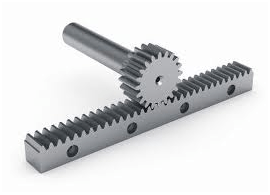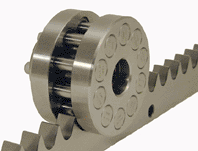- Home
- Popular products
- Rack and Pinion Gears
Rack and Pinion Gears
Rack and Pinion Gears

Rack and pinion gears are used to convert rotation into linear motion. The flat, toothed part is the rack and the gear is the pinion. A piston coaxial to the rack provides hydraulic assistance force, and an open centered rotary valve controls the assist level. A rack and pinion gears system is composed of two gears. The normal round gear is the pinion gear and the straight or flat gear is the rack. The rack has teeth cut into it and they mesh with the teeth of the pinion gear.
A ring and pinion gear is the differential's critical point of power transfer. A ring and pinion gear set is one of the simplest performance modifications that can be performed on a vehicle. The most common reason to change ring and pinion ratios from the original equipment is to retain power when bigger tires are put on a vehicle. The torque can be increased by a ratio change when there is enhanced pulling or higher take off power from a dead start. A well designed mechanism such as the rack and pinion gears save effort and time.
Gear Types
Rack and pinion gears are available in three variations:
- Straight teeth have the tooth axis parallel to the axis of rotation. Straight teeth that run parallel to the axis of the gear. Load movement or transfer is manual or walk-behind.

- Helical teeth gears provide continuous engagement along the tooth length and are often quieter and more efficient than straight tooth gears. Helical tooth gears resemble spur gears in the plane of rotation, but include teeth that are twisted along a helical path in the axial direction.

- Roller pinion drives use bearing supported rollers that mesh with the teeth of that rack in order to provide minimal to no backlash.

Quality
Rack and pinion gears variations are available in different qualities,
- 9/10 milled teeth are milled and hardened quality
- 7/8 precision cut or precision cut and hardened quality
- 5/6 teeth hardened and ground quality
Performance Specifications
The speed with which the rack moves as the pinion turns is determined by the diameter of the gear.
Application
Rack and pinion gears provide a less mechanical advantage than other mechanisms, but greater feedback and steering sensation. A rack and pinion gear gives a positive motion especially compared to the friction drive of a wheel in tarmac. In a rack and pinion railway, a central rack between the two rails engages with a pinion on the engine allowing a train to be pulled up very steep slopes.
Rack and pinions gears are commonly used in the steering system of cars to convert the rotary motion of the steering wheel to the side to side motion in the wheels. The steering wheel rotates a gear which engages the rack. As the gear turns, it slides the rack either to the right or left, depending on which way the wheel is turned. Rack and pinion gears are also used in some scales to turn the dial that displays a weight.
